Alright, adventurer! Ready to turn those furry (and scaly!) critters of Azeroth into piles of gold and awesome gear? You've come to the right place! This guide is your personal roadmap to mastering the art of Skinning in Classic WoW, taking you from a fumbling newbie with a rusty knife to a seasoned leatherworker's best friend, all the way from skill 1 to the coveted 300.
Skinning isn't just about leveling a profession; it's about fueling your adventures! It pairs amazingly with Leatherworking, letting you craft your own gear (especially killer for Rogues, Hunters, Druids, and Shamans). Plus, the demand for leather is always there, meaning a steady flow of gold into your pockets from the Auction House. It's a gathering profession you can level up pretty easily while you're out questing and slaying beasts anyway. No need to go miles out of your way hunting for special nodes like miners or herbalists often do.
We'll cover everything: the basic tools, where to find trainers, the fastest leveling paths with specific mobs and zones for both Horde and Alliance, how to make serious bank with rare leathers like Devilsaur Leather, and even some Auction House wizardry. Think of me as your friendly guide who's skinned a thousand beasts and lived to tell the tale (and get rich doing it!).
The Bare Bones: Skinning Essentials for Newbies
This section will ensure our apprentice skinner has all the foundational knowledge before they even make their first cut. It's about setting them up for success and avoiding common pitfalls.
Your First Cut: Getting the Skinning Knife and Finding a Trainer
First things first, you need your trusty Skinning Knife. You can't skin without it, friend! Grab one from any Trade Goods vendor or Leatherworking supplier. Good news: it doesn't need to be equipped, just chilling in your bags. Many a new skinner has stood over a perfectly good corpse wondering why their skinning spell won't work, only to realize their knife is still at the bank!
Next, you need a mentor. You can learn Apprentice Skinning once your character hits level 5. Don't bother trying to skin those level 1-6 critters in the immediate starting zones; the game won't let you until you've got the skill.
Finding Your Skinning Trainer:
- Your main man for starting out is Thuwd in the Valley of Honor, Orgrimmar.
- As you advance, you'll seek out Dranh at Camp Taurajo in The Barrens for Expert Skinning
- Later Kulleg Stonehorn at Camp Mojache in Feralas for Artisan Skinning.
- Other Horde trainers include Mooranta in Thunder Bluff.
- Balthus Stoneflayer in The Great Forge, Ironforge, will get you started. He can also teach you Expert.
- For Artisan Skinning, you'll visit Telonis in the Craftsmen's Terrace, Darnassus.
- Other Alliance trainers include Maris Granger in Stormwind and Helene Peltskinner in Elwynn Forest.
Here's a quick rundown of when you'll be visiting your trainers:
| Skill Level Range | Rank Name | Character Level Req. | Key Horde Trainer Locations (NPC, Zone) | Key Alliance Trainer Locations (NPC, Zone) |
|---|---|---|---|---|
| 1-75 | Apprentice | 5 | Thuwd, Orgrimmar | Balthus Stoneflayer, Ironforge |
| 50-150 | Journeyman | 10 | Thuwd, Orgrimmar | Balthus Stoneflayer, Ironforge |
| 125-225 | Expert | 20 | Dranh, The Barrens (Camp Taurajo) | Balthus Stoneflayer, Ironforge |
| 200-300 | Artisan | 35 | Kulleg Stonehorn, Feralas (Camp Mojache) | Telonis, Darnassus |
Knowing when and where to train is crucial. Hitting a skill cap without knowing where your next trainer is can halt your progress and become quite frustrating, especially if you're out in the field. This table should help you plan your training stops efficiently.
The Skinner's ABCs: How Skill-Ups, Mob Levels, and Looting Work
When you hover your mouse over a dead, fully looted beast, the game gives you a hint about skinning it via a color code on the tooltip:
- Orange: This is a tough one for your skill level, but it gives you the highest chance of a skill-up!
- Yellow: Still challenging, with a good chance for a skill-up.
- Green: Easy peasy. Low chance for a skill-up, but it can still happen.
- Gray: No challenge at all, and absolutely no chance for a skill-up. Time to find tougher beasts!
- Red: This beast is too high-level for your current skinning skill. You can't skin this yet.
A little heads-up: even if a mob is Orange to you, it DOES NOT guarantee a skill-up every single time. Skinning skill-ups are based on probability, so don't get disheartened if you skin a few orange mobs and don't see that satisfying "Your skill in Skinning has increased" message. Just keep at it!
The level of the mob you're skinning dictates what kind of leather you'll get and whether you can even attempt to skin it. You don't need to memorize complex formulas, but here's the gist:
For mobs level 1-10, you just need skill 1. For level 11-20 mobs, the skill needed is roughly (Mob Level multiplied by 10) minus 100. For mobs level 21 and up, it's generally the Mob Level multiplied by 5.
The main takeaway is simple: if mobs are gray, you need to move on to higher-level creatures. If they're red, you need to increase your skinning skill first. This guide will help you find the right mobs for your skill level.
As your skill progresses, so will the quality of leather you gather:
- Ruined Leather Scraps: From level 5-17 mobs.
- Light Leather: From level 5-27 mobs.
- Medium Leather: From level 15-38 mobs.
- Heavy Leather: From level 26-46 mobs.
- Thick Leather: From level 35-58 mobs.
- Rugged Leather: From level 45-60 mobs.
| Leather Type | Skill Range You'll Likely Get It | Typical Mob Level Source | Common Zones Where It Drops |
|---|---|---|---|
| Ruined Leather Scraps | 1-50+ | 5-17 | Starting Zones (Durotar, Dun Morogh, Elwynn, Teldrassil, Mulgore) |
| Light Leather | 1-100 | 5-27 | Starting Zones, The Barrens, Loch Modan, Darkshore, Westfall |
| Medium Leather | 75-175 | 15-38 | The Barrens, Wetlands, Hillsbrad Foothills, Ashenvale |
| Heavy Leather | 150-250 | 26-46 | Thousand Needles, Arathi, Stranglethorn Vale, Desolace |
| Thick Leather | 200-300 | 35-58 | Feralas, Tanaris, The Hinterlands, Badlands, Un'Goro Crater |
| Rugged Leather | 250-300 | 45-60 | Un'Goro Crater, Felwood, Winterspring, Plaguelands, Silithus |
This table gives you a good idea of what to expect as you level up. It's not just about chasing orange mobs for skill-ups. Often, you'll find a "sweet spot" with yellow mobs. You might kill them faster than much higher-level orange mobs, leading to more skinning attempts and thus more chances for skill-ups over the same period. Green mobs are perfectly fine if you're already killing them in large numbers for quests or XP; those occasional skill-ups are just a bonus. The trick is to balance how quickly you can kill things with the likelihood of getting a skill point.
Gear Up!: Essential Skinning Tools & Buffs
While your basic Skinning Knife is your bread and butter, a few extra tools and buffs can make your life a whole lot easier and get you to that coveted 300 skill faster.
The real magic happens when you start combining these bonuses. For instance, equipping Pip's Skinner (+10 skill) and having gloves enchanted with +5 Skinning gives you a total of +15 over your base skill. This is precisely how dedicated skinners reach the 310 or even 315 skill points needed to skin elite creatures in raids like Molten Core Hounds or the hide of Onyxia herself. It's not just about one item; it's the synergy that unlocks the highest tiers of skinning.
The Grand Expedition: Leveling Skinning 1-300 – The Speedy Route!
Alright, time for the main event! We're going to travel across Azeroth, turning countless beasts into valuable leather. I'll give you the prime spots and the critters to focus on. Remember to visit your trainer whenever you can learn a new rank! The paths here are inspired by tried-and-true methods, similar to what you might find on dedicated profession sites, ensuring an efficient journey.
1-75: Humble Beginnings (Ruined Leather Scraps & Light Leather)
Horde
Path: Start your skinning adventure around Sen'Jin Village. As you quest and explore, skin every beast you find, making your way north towards Orgrimmar.
Mobs: Boars, Scorpions, Raptors – if it has a hide and you killed it, skin it!
Trainer Stop: Once you reach Orgrimmar (this should be around skill 50-75), pay a visit to Thuwd to learn Journeyman Skinning. Even if you're not quite at 75 skill points, skill 50 is enough to train for the next rank.
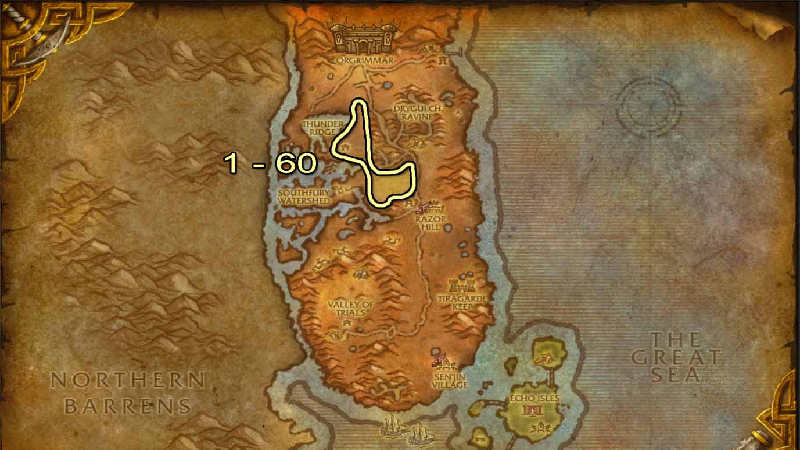
Alliance
Path (1-50): Make a wide circle around the lake near Ironforge (note: Coldridge Valley, the very starting area, is off-limits for initial skinning).
Mobs: Wolves and Bears are plentiful here.
Trainer Stop (Skill 50): Once your skill hits 50, head into the warmth of Ironforge and learn Journeyman Skinning from Balthus Stoneflayer.
Path (50-75): Continue skinning the local wildlife as you naturally quest and move towards the entrance of Loch Modan.
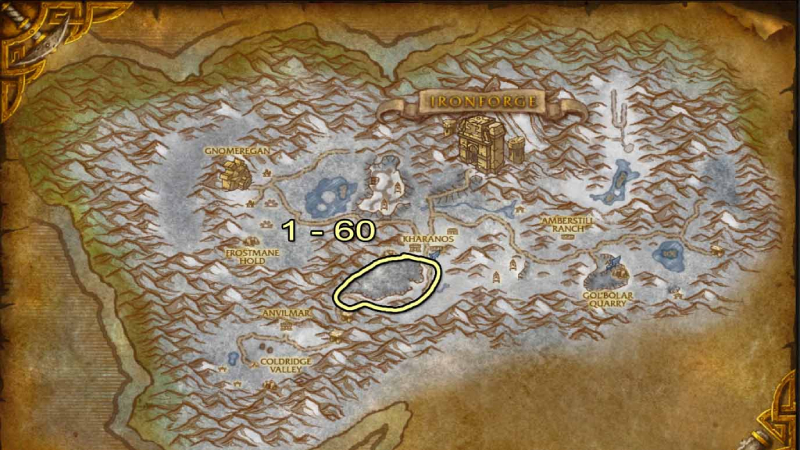
Brief Mention of Other Starting Zones:
- Mulgore (Horde): This vast plain is home to plenty of Plainstriders and Kodo. If you're a higher-level character just picking up skinning, the Armored Battleboars in Mulgore are a special case for incredibly fast power-leveling, though they primarily drop Ruined Leather Scraps.
- Teldrassil (Alliance): Night Elves can find plenty of Spiders and Nightsabers to practice on.
- Elwynn Forest (Alliance): Humans will encounter many Wolves and Boars perfect for those initial skill points.
While these paths offer a structured approach, often the most efficient way to get through the early levels (1-50ish) is simply to skin everything skinnable in your character's starting zone and the next immediate questing zone. You're already killing these beasts for experience and quests, so incorporating skinning feels natural and doesn't require dedicated "grind" time. This way, your skinning skill levels up almost passively alongside your character.
75-150: Gearing Up! (Medium Leather)
Horde
This zone is enormous and absolutely teeming with beasts – a skinner's paradise!
Path (75-125): After training Journeyman in Orgrimmar, venture into The Barrens. You'll find Plainstriders, Prowlers, Raptors, Zhevra, and Hyenas. Skin them as you quest your way towards Camp Taurajo.
Trainer Stop (Skill 125): At Camp Taurajo, seek out Dranh. He'll teach you Expert Skinning.
Path (125-150+): From Camp Taurajo, your journey takes you south towards Thousand Needles. Continue to skin everything that crosses your path. Raptors and Thunderhawks are particularly good targets in the southern Barrens.
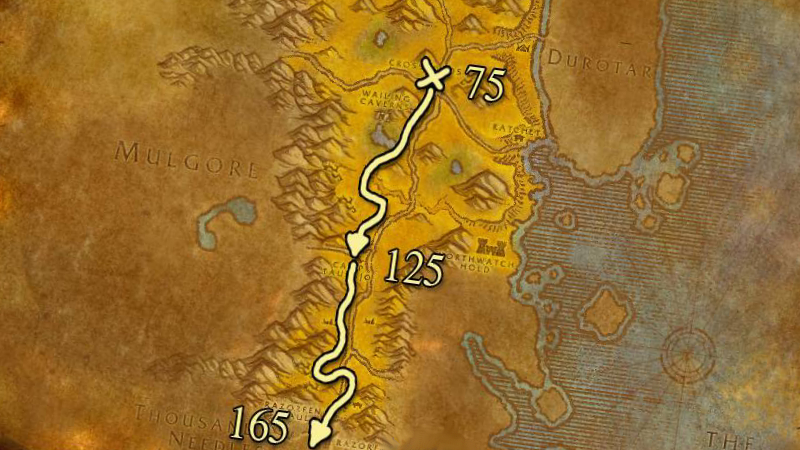
Alliance
Path (Loch Modan, ~75-115): Skin the Bears, Boars, and Spiders found around Thelsamar and the shores of the loch.
Path (Wetlands, ~115-140/150): Head south from Loch Modan into the marshy expanse of Wetlands. A great route is to follow the river south from the northern pass. You'll encounter plenty of Crocolisks, Raptors, and Mottled Scytheclaws/Razormaws, especially near Whelgar's Excavation Site. Be aware that some beasts in Wetlands might be a bit challenging if you arrive with a lower skill level. Aim to have at least 125 skill points by the time you reach Menethil Harbor.
Trainer Stop (Skill 125): From Menethil Harbor, take a flight to Ironforge. Visit Balthus Stoneflayer again to learn Expert Skinning. Afterwards, fly back to Wetlands.
Path (Wetlands, ~125-155): Continue your skinning spree in Wetlands, aiming to reach skill 155. This specific skill level is important because it will allow you to skin the level 31 Raptors in Arathi Highlands, your next major destination. Keep an eye out for Red Whelps in Wetlands; they drop Red Whelp Scales, a niche but useful crafting material.

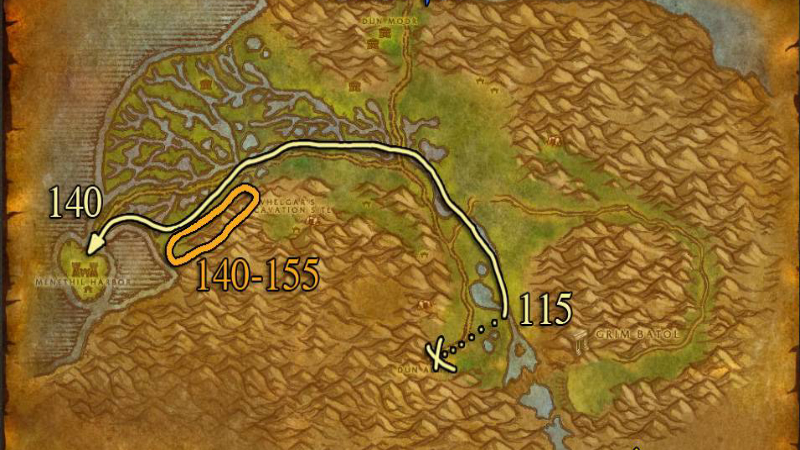
Alternative Zones for this Bracket:
- Hillsbrad Foothills: A contested territory, but rich in Bears, Mountain Lions, and Spiders. The Yetis inside the Foothill Caverns are an excellent source of Medium Leather, though higher-level players might clear the cave too quickly and have to wait for respawns.
- Ashenvale: Home to Terrowulfs (wolves), Bears, and Stags.
- Stonetalon Mountains: Pridewing Wyverns and various Spiders offer good skinning opportunities, especially for those at the lower end of this skill bracket.
150-225: The Big Leagues (Heavy Leather & Early Thick Leather)
Horde
Path (150-205): This canyon landscape is filled with raptors, basilisks, scorpids, and hyenas. The area around the Shimmering Flats and the winding canyons leading south are excellent hunting grounds. Make sure you hit skill 205 before you decide to leave this zone.
Trainer Stop (Skill 200/205): Once you've achieved skill 205, make your way to Tanaris. From Gadgetzan, take a flight to Camp Mojache in Feralas. There, you'll find Kulleg Stonehorn, who will teach you Artisan Skinning.
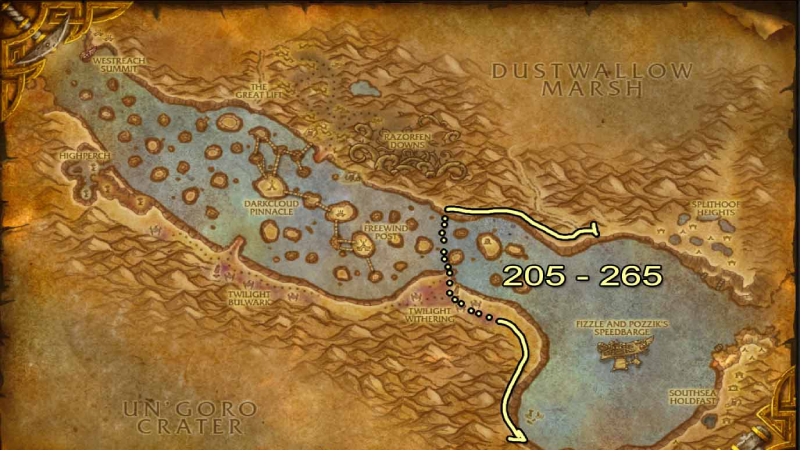
Alliance
Path (155-170): Skin the raptors, spiders, and lions that roam the plains and rocky outcrops of Arathi.
Path (170-205): Shift your focus to the higher-level raptors, particularly in the eastern and southeastern parts of the zone. A word of caution: there are some level 36-37 raptors lurking in the southeast corner. Avoid them until your skinning skill is around 180, as you won't be able to skin them before then and they hit hard!
Trainer Stop (Skill 200/205): Take a flight back to Ironforge and learn Artisan Skinning from your old friend Balthus Stoneflayer.
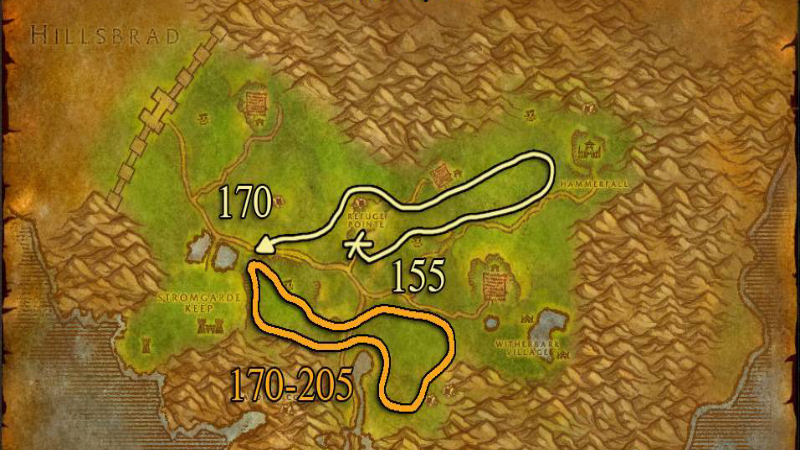
Alternative Zones for this Bracket:
- Stranglethorn Vale: A classic leveling hub, STV is packed with Tigers, Panthers, Raptors, and Basilisks. The Ironjaw Basilisks inside the cave north of Grom'gol are a good source of Thick Leather if your skill is at the higher end of this bracket, but be warned that high-level characters might clear the cave too fast for efficient respawns.
- Alterac Valley (the zone, not the battleground for this specific farming): The Yetis in the caves and the Mountain Lions offer good skinning opportunities.
- Dustwallow Marsh (especially for Thick Leather as you approach 200+ skill): Raptors and Crocolisks are common. The mobs in Stonemaul Ruins are notable because they can sometimes drop two pieces of leather instead of one when skinned!
225-300: Master of the Blade (Thick Leather & Rugged Leather)
Primary Zones (Both Factions):
This zone remains a skinner's haven for a significant portion of this bracket.
- 205-230: Skin the various beasts around Camp Mojache. This area is convenient for both Horde and Alliance players. Target Wolves, Hippogryphs, and Yetis.
- 230-260: Make your way to the Yeti cave located in the northwestern part of Feralas (it's often marked on popular skinning maps online). Yetis are an excellent source of Thick Leather. If the cave is heavily farmed by other players, the Hippogryphs south of Camp Mojache serve as a great alternative.
- 260-280: There's another Yeti cave, often referred to as being in the Twin Colossals area, which houses higher-level Yetis. The beasts found roaming in front of this cave are also good for skinning. At skill 280, you can choose to stay in Feralas or make the journey to Un'Goro Crater.
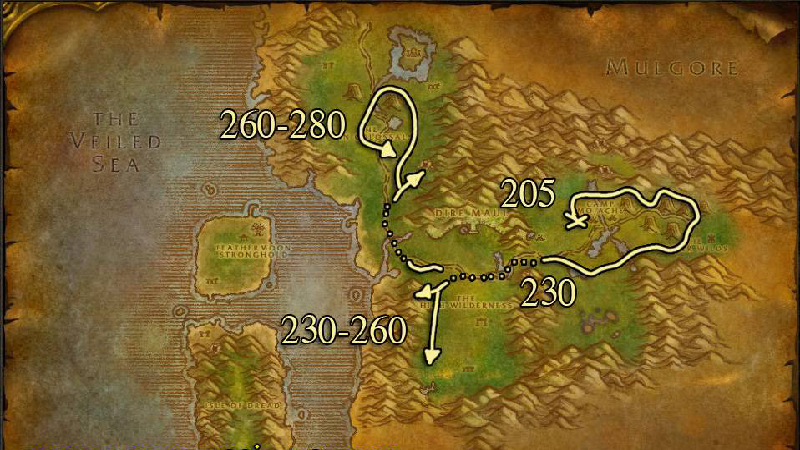
Welcome to Jurassic Park... Azeroth style! This crater is prime dinosaur territory.
You'll be hunting Frenzied Pterrordax, Elder Diemetradon, various Ravasaurs (which have a great drop rate for Thick Leather, around 75%), and Gorillas. If you arrive closer to skill 250, it's wise to stick to the edges of the crater. As your skill (and character level) increases, you can venture deeper into the more dangerous areas. The western part of Un'Goro is particularly good for farming Rugged Leather from the dinosaurs there.
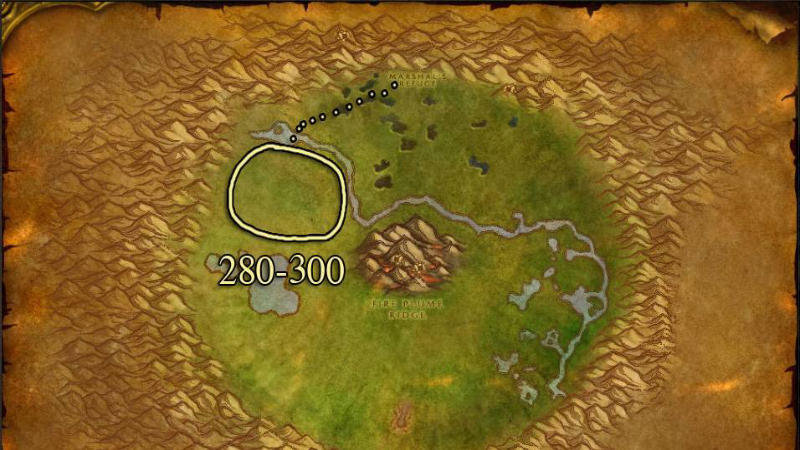
High-Level Hotspots (Primarily for Rugged Leather, skill ~260/275+):
- Felwood (Mob Levels 47-50): A solid alternative if Un'Goro Crater feels too challenging or is overly crowded. Your main targets here will be Felpaw Wolves and Angerclaw Bears. For slightly tougher prey, look for Angerclaw Maulers and Felpaw Scavengers just north of the small river in the zone.
- Winterspring (Mob Levels 55-58): Many consider Winterspring one of the absolute best places to farm Rugged Leather. Head to the snowy fields south of Everlook. You'll find an abundance of Ice Thistle Patriarchs, Ice Thistle Matriarchs, and Ice Thistle Yetis. They populate the open areas and are even more concentrated inside the nearby cave. The only downside is that its reputation often means you'll face stiff competition from other skinners.
- Eastern Plaguelands (Mob Levels 53-58): This blighted zone offers two fantastic farming spots for Rugged Leather. The northern area is home to higher-level Frenzied Plaguehounds and Monstrous Plaguebats. The southern area is a bit easier, with Plaguehound Runts and Plaguebats. Both are excellent choices for stocking up on Rugged Leather.
- Western Plaguelands (Mob Levels ~51-55): While detailed routes aren't as common in guides for this zone specifically for skinning, it's a high-level area teeming with beasts. You can find Plaguewood Bears and Carrion Grubs. Plaguehounds are also present. These mobs should provide a good supply of Rugged Leather.
Power Leveling Hotspots (for higher-level characters wanting to max skinning fast):
Mulgore - Armored Battleboars: If you're a level 50+ character, you can AoE these down with ease. They respawn incredibly quickly, and most of them don't drop any loot, which means you can skip the looting animation and get straight to skinning. You'll mostly get Ruined Leather Scraps, but it's reported you can go from 1-300 in about 15-20 minutes using this method, especially if you pop a Darkmoon Firewater.
Wetlands - Dragonmaw Whelpstealers vs. Ebon Slavehunters: East of Greenwarden's Grove, you'll find these groups fighting. This spot is recommended for level 50+ characters who can AoE them down. You'll be skinning the Ebon Slavehunters. The respawn rate is fast enough to keep you busy.
Pro Skinner Secrets: Tips, Tricks, & Making Life Easier
So, you're well on your way to becoming a master skinner! But even the best can learn a few new tricks. Let's talk about making your skinning life smoother, more profitable, and maybe even a bit more fun.
Skinning on the Go: Weaving it into Your Leveling Adventure
This is perhaps the most important tip for anyone starting a new character or an alt. If you're leveling, especially a class that can make good use of leather (like Rogues, Hunters, Druids, or Shamans), take Skinning as one of your professions right from level 5!
The golden rule is to skin EVERYTHING that's skinnable after you kill it during your quests. It only takes a few extra seconds per mob, but over the course of leveling from 1 to 60, this adds up to a massive amount of skill points and valuable materials. This approach makes leveling your Skinning feel much more organic and less like a dedicated grind. You'll often find that your skinning skill naturally keeps pace with the level of the zones you're questing in, meaning you're always able to skin the beasts you're fighting for XP. This synergy is incredibly efficient; you're essentially leveling two things at once – your character and your profession – with minimal extra effort.
Macro Magic: Simple Macros for Skinning Efficiency
In Classic WoW, every click can feel like it adds up, especially during long farming sessions. Macros are simple tools that can save you time and make repetitive actions much smoother.
One-Button Skinning (Mouseover):
#showtooltip Skinning
/cast [@mouseover,dead,exists] Skinning
How it Works: Instead of clicking to target a dead beast and then clicking your skinning spell, this macro lets you simply hover your mouse cursor over a skinnable corpse and press the macro key. It's a small change that makes a big difference when you're skinning dozens or hundreds of mobs.Gear Swapping Macro (for +Skill Items):
/equip Pip's Skinner
/equip YourMainCombatWeapon
The Idea: The goal is to press the macro once to equip your skinning gear (dagger, and maybe even separate +5 skill gloves if you have them and are out of combat), and then press it again to switch back to your combat set.Dismount & Cast (for efficient pulling):
/dismount
/cast Hunter's Mark
Why it's useful: This prevents that awkward moment where you try to cast a spell while still mounted, only for nothing to happen. This macro ensures you dismount and immediately cast, saving precious seconds.These macros aren't just for hardcore min-maxers; they're about improving your gameplay flow and reducing tedium. The mouseover skinning macro alone will save you a surprising number of clicks over your skinning career, making the whole process feel smoother and more enjoyable.
The Perfect Pair: Skinning & Leatherworking Synergy
If there was ever a match made in Azerothian heaven, it's Skinning and Leatherworking. They complement each other perfectly.
- Ultimate Self-Sufficiency: With Skinning, you provide the vast majority of the raw materials – all those leathers and hides – that your Leatherworking skill needs to craft armor, armor kits, bags, and other useful items. This is incredibly powerful for classes that wear Leather or Mail armor (Hunters, Rogues, Druids, and Shamans after level 40), as you can often upgrade your own gear while you're leveling, without spending a copper at the Auction House.
- Gold-Making Powerhouse: Beyond gearing yourself, this combination can be very profitable. You can craft desirable items like armor kits, or highly sought-after pieces of gear like the Devilsaur set, and sell them for a handsome profit.
- Targeted Farming: When you're leveling both professions simultaneously, you'll have a clear understanding of exactly which types of leather you need for your upcoming Leatherworking recipes. This makes your skinning efforts much more focused and efficient.
Pairing Skinning with Leatherworking offers more than just a convenient supply of materials; it grants you a significant degree of economic independence. You're not at the mercy of fluctuating Auction House prices for your primary crafting components. This also gives you complete control over your crafting pipeline, allowing you to prioritize items for your own character's progression or to capitalize on high-profit market opportunities. It's a direct value chain that you manage from beast to finished product.
Beyond the Cap: Farming Azeroth's Most Valuable Leathers
Hitting 300 Skinning is a fantastic achievement, but it's just the beginning of your journey to true skinner mastery (and riches!). Now, the real fun begins as we hunt down some of Azeroth's most elusive beasts for their incredibly valuable leathers and hides.
The Devilsaur Gold Rush: Your Path to Riches!
Listen closely, friend, because this is where the serious gold is made. Devilsaur Leather is legendary in Classic WoW – it's practically liquid gold. Why all the fuss? Because it's the key ingredient in crafting the Devilsaur Armor set:
- Devilsaur Gauntlets: These require 8 Devilsaur Leather and 1 Rune Thread, and you'll need a Leatherworking skill of 290 to craft them.
- Devilsaur Leggings: These demand 14 Devilsaur Leather, 1 Cured Rugged Hide, and 1 Rune Thread, requiring Leatherworking 300.
This two-piece set provides a crucial +Hit Chance bonus, making it pre-raid Best-in-Slot (BiS) for a multitude of physical DPS classes, including Rogues, Warriors, Hunters, and Feral Druids. The demand for this set, and therefore its leather, is consistently sky-high.
Meet the Terrors of Un'Goro Crater:
Your targets are the mighty Devilsaurs, and they only roam the prehistoric landscape of Un'Goro Crater. These are not pushovers; they are all elite creatures and pack a serious punch! You'll encounter a few varieties:
All of these elite Devilsaurs found in Un'Goro can be skinned for the prized Devilsaur Leather.
Staking Your Claim: Prime Devilsaur Hunting Grounds in Un'Goro Crater:
- Un'Goro Crater is the exclusive home of these valuable beasts.
- Spawn Points & Paths: Devilsaurs don't just stand around; they patrol specific paths throughout the crater. Generally, there are about four main spawn locations or patrol routes. A common and effective strategy is to identify two or three of these spawn points and create a rotation, moving between them to check for respawns. While specific maps aren't always detailed in every guide, experienced hunters know these routes well. For example, one might patrol near the Slithering Scar, another might circle the area around Fire Plume Ridge, and others roam the open plains.
- Spawn Timers: The respawn time for a Devilsaur is roughly every 7 to 15 minutes. Some farmers suggest that clearing all four known spawn locations might take around 30 minutes for a full cycle. Efficiently timing these spawns is absolutely critical to maximizing your leather-per-hour yield.
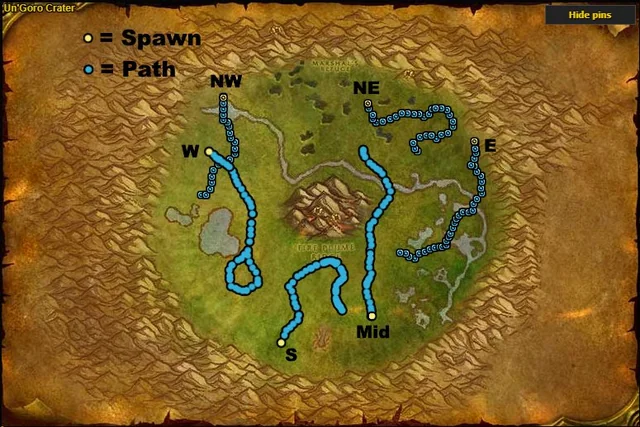
Navigating the Competition: Farming Strategies & Tales of the "Devilsaur Mafia"
- High Demand, High Competition: Because Devilsaur Leather is so incredibly valuable, Un'Goro Crater is often a fiercely contested zone. Expect to encounter other farmers, and on PvP servers, be prepared for frequent, and often brutal, world PvP.
- The "Devilsaur Mafia": On many Classic WoW servers, tales abound of organized groups, sometimes even collaborating across factions, attempting to control the Devilsaur spawns. These groups might resort to various tactics, from aggressively killing competitors and "tag-stealing" mobs to using intimidation and even mass reporting.
The hunt for Devilsaur Leather is more than just a farming activity; it's a significant economic driver within the game and a potent catalyst for world PvP and complex player-driven social dynamics, like the infamous "Devilsaur Mafia." The inherent scarcity of the resource (limited spawn points, confined to a single zone) combined with its extremely high demand (for Best-in-Slot gear) creates a perfect storm for conflict and organized efforts to control the market. This transforms Un'Goro Crater into one of the most dynamic, and often dangerous, zones in Classic WoW, perfectly reflecting the emergent, player-driven narratives that make the game so unique.
Other Lucrative Hides & Scales:
While Devilsaur Leather often steals the spotlight, there are plenty of other valuable materials a skilled skinner can acquire.
Thick Hide:
- Sources: This is a less common drop than Thick Leather from the same tier of mobs. Prime farming spots include the Yetis in Feralas's caves, the various Ravasaurs in Un'Goro Crater, and a variety of beasts in Dustwallow Marsh. Player discussions also frequently mention the turtles in Tanaris and the dragonkin around the Sunken Temple in the Swamp of Sorrows as decent sources, often yielding Thick Hides alongside Thick Leather. Dungeons like Blackrock Depths (from Bloodhounds) and the Sunken Temple are also noted for Thick Leather, and thus likely Thick Hides too.
- Value: Thick Hides are essential components in many higher-level Leatherworking recipes, particularly for crafting Cured Thick Hide, which is then used in patterns like the Devilsaur Leggings.
Warbear Leather:
Warbear Leather is the key ingredient for crafting the Warbear Harness and Warbear Woolies. The patterns for these items are sold by Meilosh, the quartermaster for the Timbermaw Hold faction, once you reach Friendly reputation.
Black Dragonscales:
- Sources: These are skinned from elite Black Dragonkin.
- Burning Steppes: Scalding Whelps and other black dragonkin found near lava pools and caves, particularly around the area known as Firemaw's Lair, are prime targets.
- Searing Gorge: The areas near Blackrock Mountain also host these dragonkin.
- Blackrock Spire (Lower and Upper): Many of the trash mobs within these dungeons, especially the dragonkin, can be skinned for Black Dragonscales.
- Dustwallow Marsh: While some whelps here are known for Worn Dragonscales, higher-level black dragonkin, if present in sufficient numbers, could also yield Black Dragonscales.
- Uses & Value: Black Dragonscales are crucial for crafting fire resistance gear, such as the Black Dragonscale Breastplate, Boots, Shoulders, and Leggings. This gear is essential for raiders venturing into Molten Core and Blackwing Lair.
Green Dragonscales:
- Sources: Primarily obtained from skinning the dragonkin found within the Sunken Temple (Temple of Atal'Hakkar) in the Swamp of Sorrows. Specific mobs include Nightmare Scalebane, Nightmare Wyrmkin, Nightmare Wanderer, and Nightmare Whelp. Dragonkin in the open world of Swamp of Sorrows are also a source.
- Uses & Value: Green Dragonscales are used for crafting nature resistance gear and other specific Leatherworking items, including the Green Dragonscale Set, which can be valuable for encounters involving nature damage.
Raid & Dungeon Treasures:
Skinning Core Hounds requires a Skinning skill of 310. This means your base 300 skill isn't enough; you'll absolutely need +Skinning skill gear like Pip's Skinner or the Zulian Slicer (+10), and likely the +5 glove enchant as well.
Similar to Core Leather, skinning The Beast requires a Skinning skill of 310. This is because The Beast is a level 62 creature. Again, +skill gear is non-negotiable.
Here's a quick reference for these top-tier materials:
| Material Name | Primary Source (Mob/Zone) | Min. Skinning Skill (if >300) | Key Uses/Value |
|---|---|---|---|
| Devilsaur Leather | Devilsaurs (Un'Goro Crater) | Normal (275+) | Devilsaur Armor set (Pre-Raid BiS Hit gear) |
| Thick Hide | Yetis (Feralas), Ravasaurs (Un'Goro), various L40-50+ beasts | Normal (200+) | Cured Thick Hide, various LW recipes |
| Warbear Leather | L50-60 Bears (Winterspring, Felwood, Blasted Lands) | Normal (250+) | Warbear Harness, Warbear Woolies (Timbermaw Rep patterns) |
| Black Dragonscale | Elite Black Dragonkin (Burning Steppes, Searing Gorge, LBRS/UBRS) | Normal (275+) | Fire Resistance gear (e.g., Black Dragonscale set for MC/BWL) |
| Green Dragonscale | Dragonkin (Sunken Temple, Swamp of Sorrows) | Normal (225+) | Nature Resistance gear (e.g., Green Dragonscale set) |
| Core Leather | Ancient Core Hounds, Magmadar (Molten Core) | 310 | High-end epic crafts, Tier 1 set pieces |
| Pristine Hide of the Beast | The Beast (Upper Blackrock Spire) | 310 | Powerful epic gear (e.g., Breastplate of Bloodthirst) |
Items like Core Leather and the Pristine Hide of the Beast aren't just rare because of their drop rates; they are also gated by a high skinning skill requirement (310+). This naturally limits the pool of players who can even attempt to acquire them, which in turn significantly boosts their market value. It underscores the importance of not just reaching the 300 skill cap in Skinning, but also actively seeking out and utilizing specific +skill gear such as Pip's Skinner or the Zulian Slicer. This "skill gate" acts as an economic control, ensuring these particular leathers remain premium commodities on any server. Maxing your profession skill is only the first step; gear optimization for those crucial extra skill points becomes paramount if you want to access the most lucrative skins in Azeroth.
From Hides to Gold: Dominating the Auction House
You've done the hard work, your bags are bulging with leather – fantastic! But raw materials don't pay for epic mounts or raid consumables. It's time to learn the subtle art of the Auction House and turn those stacks of hides into a mountain of gold.
Know Your Worth: Checking Leather Prices Like a Pro
Knowledge is power, especially when it comes to making gold. Don't just guess what your leather is worth!
Selling Smart: Best Practices for Listing Your Leathers
Knowing the price is one thing; getting that price is another. Here are some tips for listing your leathers effectively:
For common leathers like Light, Medium, Heavy, Thick, and Rugged Leather, full stacks of 20 often sell well. However, also consider listing some in smaller stacks of 5 or 10. Leatherworkers often need specific, smaller quantities for particular recipes and might pay a slight premium for the convenience of not having to buy a full stack.
For rare and expensive leathers like Devilsaur Leather, Warbear Leather, or Core Leather, it's standard practice to sell them individually or in very small stacks due to their high per-item value.
- Undercutting – The Necessary Evil (Done Wisely): Undercutting the current lowest price by a tiny margin (often just 1 copper) is standard practice to get your auction listed first. However, avoid making huge undercuts, as this can quickly devalue the item for everyone. Most Auction House addons have features to help you undercut intelligently.
- Timing Your Sales for Peak Demand:
- Materials used for raid consumables (like ingredients for flasks or food that might indirectly use leather products) or popular crafted raid gear often see higher demand and prices leading up to your server's main raid reset days.
- General leveling leathers, like Light or Medium Leather, tend to have more consistent demand throughout the week as players are always leveling new characters and professions.
- Be Mindful of Listing Fees: Don't list items with very short durations if they are niche or slow sellers, as the cost of repeatedly relisting them can eat into your profits. For common leathers that sell relatively quickly, 12 or 24-hour auction durations are usually fine.
Craft or Sell Raw?: A Quick Look at Leatherworking Profits
If you've paired Skinning with Leatherworking, you'll often face a crucial decision: should you sell your raw leathers, or craft them into items to sell?
- Generally faster and easier
- Caters to crafters who want materials immediately
- No need to worry about pattern availability
- Consistent demand from leveling leatherworkers
- Can yield significantly higher profits
- Selling convenience and finished products
- Need to research market demand carefully
- Requires investment in patterns and other materials
- The Big Question – Analyze the Market: There's no single right answer; it depends entirely on your server's economy. Use your Auction House addon to compare the current market price of raw leathers against the selling price of items you can craft with them (like armor kits or popular pieces of gear). Don't forget to factor in the cost of any other materials needed for the craft (thread, salt, dyes, etc.) to calculate your potential profit margin.
- Low-Level Armor Kits: Items like Light Armor Kits, Medium Armor Kits, and Heavy Armor Kits can be consistent, if modest, sellers. Players leveling Leatherworking often need to craft these, and others buy them for applying cheap enchantments to leveling gear.
- High-Value Crafted Gear: If you have the patterns and the leathers, crafting highly sought-after items like Devilsaur Gauntlets and Leggings, Warbear Harness and Woolies, or specific fire/nature resistance gear for raiders can be significantly more profitable than selling the raw leathers alone.
- The Vendor Shuffle (A Niche Strategy): Sometimes, particularly if certain leathers are very cheap on the Auction House, you might find that some crafted items actually vendor for more than the cost of their materials. For example, some guides mention that Nightscape Headbands could, at times, be crafted and sold to a vendor for a small but guaranteed profit. This requires careful calculation but can be a risk-free way to make a bit of gold.
Ultimately, the decision to sell raw materials or crafted goods often comes down to the value of convenience and market saturation. Selling raw leather is generally faster and easier; you're catering to crafters who want the materials immediately and are willing to pay for them. However, crafting specific, in-demand items can yield higher profits because you're not just selling leather; you're selling a finished product, convenience, or a solution to a player's gear needs. The profitability of either approach heavily depends on how saturated the market is for both the raw materials and the crafted items. If everyone is out farming Thick Leather, its price will likely drop, which might make crafting items from that cheap Thick Leather more profitable, and vice-versa. Keep an eye on these dynamics!
Parting Words: Go Forth and Prosper, Skinner!
Phew! We've covered a LOT of ground, my friend – from your first shaky cuts on a Durotar boar to facing down the mighty Devilsaurs of Un'Goro Crater. You're now armed with the knowledge to not only max out your Skinning skill but also to turn it into a seriously profitable venture in Classic WoW.
Quick Recap: Remember the fundamentals: always have your trusty skinning knife in your bags, make sure to loot a beast completely before you try to skin it, pay close attention to mob levels and the color codes they give you, and don't forget to visit your trainers to learn new ranks! Don't be afraid to explore those prime farming spots we talked about, and definitely try your hand at hunting down those valuable rare leathers – that's where the real gold is.
A Little Story from the Trail: I remember one time, way back in the day, I was leveling my Hunter through Duskwood. I stumbled upon a Mage who was expertly AoE farming packs of Worgen. I wasn't nearly strong enough to take on those packs myself at the time, but man, I became a skinning machine just following in their wake! I must have skinned hundreds of Worgen that afternoon, and I made an absolute fortune in Medium Leather and Heavy Leather without firing a single arrow for most of it. It just goes to show, sometimes the best skinning opportunities are the ones you stumble upon, or the ones where you cleverly capitalize on someone else's hard work (with their permission, of course, if you're in a group!). Keep your eyes peeled!
So, get out there, adventurer! Sharpen that knife, consult your maps, and turn the diverse wildlife of Azeroth into your personal gold mine and a source of fantastic crafted gear. Happy skinning, friend, and may your bags always be overflowing with valuable hides and even more valuable coin!
